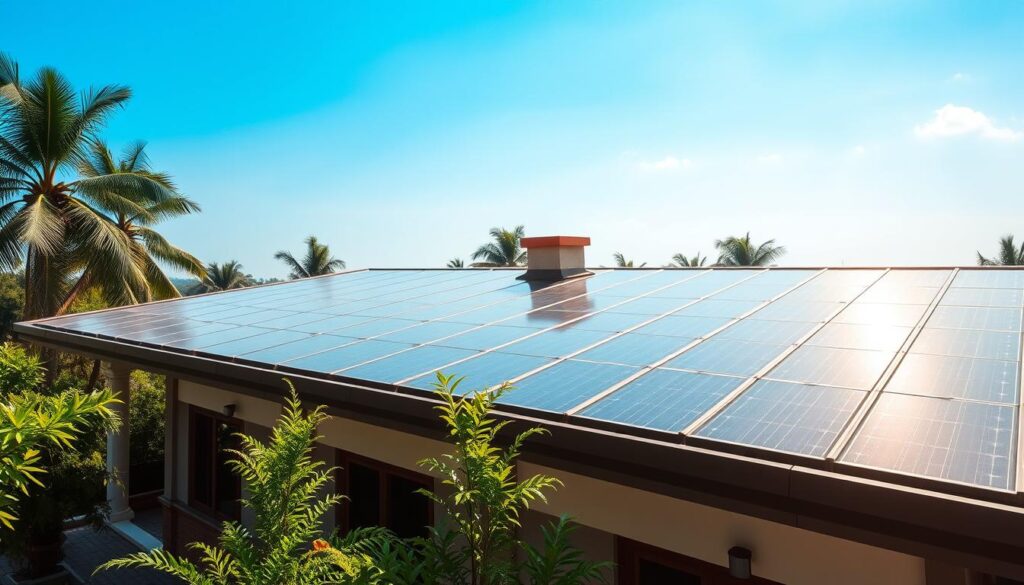Solar Roof Tiles in India: A Stylish and Sustainable Solution
Discover the benefits of solar roof tiles for Indian homes. Learn how these innovative tiles generate clean energy, reduce electricity bills, and enhance your home’s aesthetics. Explore the latest trends, costs, and government incentives.
India, with its abundant sunshine, is ripe for harnessing solar energy. Traditional solar panels, while efficient, often disrupt the aesthetics of a building. Enter solar roof tiles – a revolutionary solution that seamlessly integrates solar technology into your roofing system. These tiles not only generate clean electricity but also enhance the visual appeal of your home.
What is Solar Roof Tiles?
It’s also known as photovoltaic (PV) roof tiles, are innovative building materials that combine the functionality of traditional roof tiles with the power of solar energy. They are designed to replace conventional roof tiles, offering a visually appealing and energy-efficient solution.

Benefits
- Aesthetically Pleasing: Unlike traditional solar panels, it blend seamlessly with your roof, enhancing its overall appearance.
- Energy Generation: These tiles convert sunlight into electricity, reducing your reliance on the grid and potentially lowering your electricity bills.
- Durability: They are designed to withstand harsh weather conditions, ensuring long-term performance.
- Environmental Friendliness: By generating clean energy, they contribute to a sustainable future and reduce your carbon footprint.
- Increased Property Value: Installing solar roof tiles can potentially increase the value of your home.
Types
- Crystalline Silicon Solar Tiles: These tiles use traditional crystalline silicon solar cells, offering high efficiency but might be slightly thicker than other options.
- Thin-Film Solar Tiles: Employing thin-film technology, these tiles are lighter and more flexible, allowing for various design possibilities.
- Glass-Glass Solar Tiles: Constructed with glass on both sides, these tiles offer superior durability and aesthetics.
Cost Considerations
The initial cost of installing it is generally higher than traditional roofing materials. However, the long-term savings on electricity bills, coupled with potential government incentives, can offset the investment. Factors influencing the cost include the size of your roof, the type of solar tiles chosen, and local installation rates.
Government Incentives and Policies
The Indian government has implemented various policies and incentives to promote solar energy adoption. These initiatives aim to make solar power more affordable and accessible to homeowners. It’s essential to research the latest government programs and subsidies in your region.
Key Takeaways
- It offers a stylish and sustainable solution for harnessing solar energy.
- They can significantly reduce electricity bills and contribute to a greener future.
- While the initial investment might be higher, long-term savings and potential government incentives make them a worthwhile consideration.
- Different types of solar roof tiles are available, catering to various aesthetic and budget preferences.
Conclusion
It represent a promising avenue for India to embrace clean energy while enhancing the beauty of homes. By combining aesthetics with functionality, these innovative tiles offer a compelling proposition for homeowners seeking to reduce their carbon footprint and energy costs. As technology advances and costs continue to decline, they are poised to become a mainstream choice for sustainable living.
Frequently Asked Questions (FAQs)
- Are solar roof tiles suitable for all types of roofs?
While most roof types can accommodate factors like roof orientation, slope, and shading should be considered. - How long do solar roof tiles last?
It typically have a lifespan of 25-30 years, similar to traditional roof tiles. - Do I need a battery backup?
While not mandatory, a battery backup can store excess solar energy for use during power outages or peak demand periods. - Can I install solar roof tiles myself?
It’s recommended to hire a professional installer to ensure optimal performance and safety. - What is the payback period for it?
The payback period varies depending on factors such as electricity rates, solar incentives, and the size of your solar system.
Note: It’s essential to consult with a solar energy expert to assess the suitability of roof tiles for your specific needs and to explore available government incentives and financing options.
Contact us for know more about solar roof tiles .

